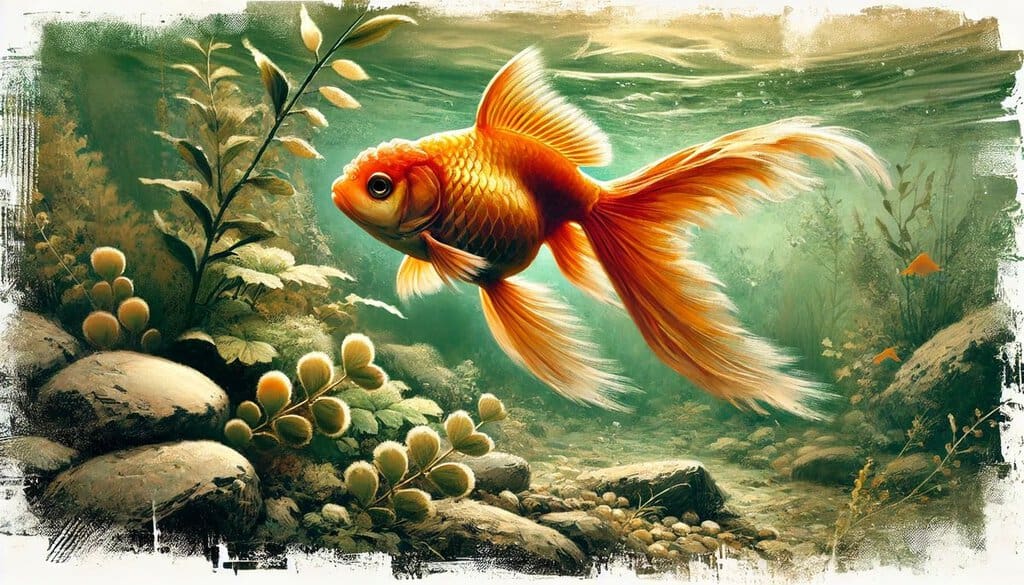The common Goldfish (Carassius auratus) are popular ornamental fish in aquaponics systems due to their hardiness and adaptability. They are closely related to koi and are often used as model organisms in laboratory environments[1]. Goldfish are particularly suitable for aquaponics because they are resistant to variations in temperature, water quality, and diet, and can tolerate handling and experimental stress[1]. The picture is an artistic rendering of a fancy goldfish variant; there are many variants to choose from.
Natural Habitat and Behavior
Origin and native environment: Goldfish are native to East Asia, originally found in slow-moving rivers, ponds, and lakes.
Natural behavior in the wild: Goldfish are omnivorous and tend to scavenge for food at the bottom of water bodies.
Temperament: Goldfish are generally docile and can be kept in groups.
Compatibility: Goldfish can be kept with other peaceful fish species in aquaponics systems, but faster variants like the comet should not be kept with tiny, slow fish as they will become food over time. Smaller fin-nipping fish are not recommended to keep with these fancy longfin goldfish as their fins risk being nipped on.
Water Requirements
Temperature Range:
- Ideal temperature: 20-25°C (68-77°F)
- Goldfish can tolerate a wide range of temperatures, but extreme fluctuations should be avoided.
pH Level:
- Recommended pH range: 6.5-8.0
- Goldfish are relatively tolerant to pH fluctuations.
Oxygen Levels:
- Ideal dissolved oxygen levels: Above 5 mg/L
- Goldfish can tolerate lower oxygen levels but thrive in well-oxygenated water.
Ammonia/Nitrate Sensitivity:
- Goldfish are moderately tolerant to ammonia and nitrate, but levels should be kept low for optimal health.
- Regular water quality monitoring is essential to prevent toxicity issues.
Tank or Pond Setup
Tank/Pond Size Requirements:
- Minimum recommended tank size: 75 liters (20 gallons) for a small group
- Density: Up to 500-700 fish per m³ in aquaponics systems[1][5]
Filtration & Aeration:
- Adequate filtration and aeration are crucial for goldfish in aquaponics systems.
- Bio-filters are essential for the nitrification process[2].
Feeding Requirements
Diet:
- Goldfish are omnivores and can be fed a variety of foods.
- Commercial pellet food with 33% protein content has been used successfully in aquaponics systems[5].
Feeding Techniques:
- Feed 2-3 times daily, offering an amount that can be consumed within 5 minutes.
- Feeding rate: Approximately 5% of body weight per day[5].
Growth and Reproduction
Growth Rate:
- Goldfish grow relatively quickly in optimal conditions.
- In a 36-day study, goldfish fry grew from an initial weight of 3.32 ± 0.45 g to a final weight that varied based on stocking density[5].
Breeding Behavior:
- Goldfish can breed in aquaponics systems, but controlled breeding may require separate breeding tanks. Lots of hiding places can help fry to survive.
- Water temperature and photoperiod changes can trigger breeding behavior.
Pros and Cons
- Hardy and adaptable to various water conditions
- Efficient nutrient producers for plant growth
- Suitable for beginners and experienced aquaponics practitioners
- May require larger systems for optimal growth
- They can produce significant waste, so robust filtration is advised.
Overall Suitability:
- Goldfish are excellent for both beginners and experienced aquaponics enthusiasts, suitable for ornamental and educational purposes.
Common Health Issues and Solutions
Potential Diseases:
- Susceptible to common fish diseases such as ich and fin rot
- Stress from poor water quality can lead to health issues
Signs of Health Issues:
- Clamped fins, erratic swimming, loss of appetite, and changes in coloration
Treatment Recommendations:
- Maintain optimal water quality through regular monitoring and water changes
- Quarantine and treat affected fish if necessary, using appropriate medications outside the AP system.
Maintenance Tips for Long-Term Health
Maintenance Frequency:
- Regular water quality testing (at least weekly)
- Perform partial water changes as needed, based on water quality parameters
System checks:
- Monitor temperature, pH, dissolved oxygen, and nutrient levels regularly
- Use IoT-based monitoring systems for real-time data collection and analysis[2][4]
Handling Practices:
- Minimize handling to reduce stress
- Use nets when transferring fish, and ensure hands are wet when handling is necessary
Closing Thoughts
Goldfish are an excellent choice for aquaponics systems due to their hardiness, adaptability, and efficient nutrient production. They are suitable for both beginners and experienced practitioners, offering a balance between ease of care and system productivity. When properly managed, goldfish can thrive in aquaponics environments, contributing to a successful and sustainable ecosystem.
Other fish species for aquaponics
External sources:
[1] https://pubmed.ncbi.nlm.nih.gov/35553361/
[2] https://www.semanticscholar.org/paper/7761c7c8d515268f09c0a757a50514cd94ac7bdc
[3] https://www.semanticscholar.org/paper/8c93dfaa1cb866393ec455ae420fb7be3b8c58d1
[4] https://www.semanticscholar.org/paper/377d0b390f95e05ee581cfb892005975ca073311
[5] https://www.semanticscholar.org/paper/8d8682638bd82d6bad5f636c8e85f7b2abce3607

